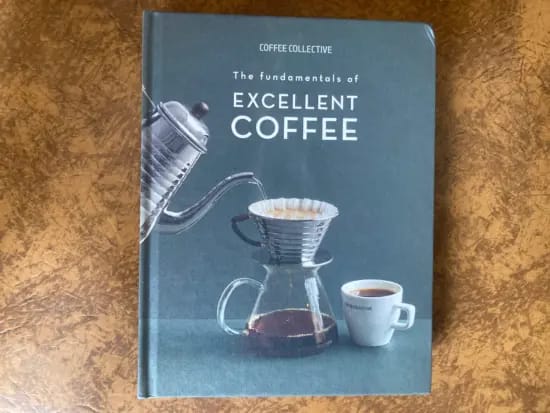BY TANYA NANETTI SENIOR ONLINE CORRESPONDENT
Photos by Tanya Nanetti
In my decade of being in love with specialty coffee, I’ve had the opportunity to read many coffee books, covering every aspect of coffee in every possible way. I’ve read books written by the best-known coffee experts, books dealing with coffee terroir and the exciting new world of Canephora coffee, books filled with coffee recipes, and novels about the history of coffee.
But the world of coffee books is endless, and many exciting new books are waiting on my shelf for the right time to be read.
The Fundamentals
Recently I finally had an opportunity to read The Fundamentals of Excellent Coffee, written by the founders of Coffee Collective, one of Denmark’s most famous specialty roasters. The book was first published in 2012 in Danish under the title Grundbog i God Kaffe. An updated version was written in 2021 and translated into German and English; the update includes new chapters covering the history of coffee and its sustainability.
The purpose of the book is clearly stated right from the foreword. Through chapters covering cultivation, roasting, and brewing, the goal is to help all interested parties learn more about great coffee. Coffee Collective hopes to help people make informed decisions when it comes to finding better coffees and making the most of them.
Where It Begins
The first chapter, “A New Look at Coffee,“ introduces coffee by comparing it to wine. The book shares what the two have in common: the importance of producers, farms, and varieties. It also explains the ways they differ geographically and historically, and in the number of players involved in achieving a perfect final cup (which is much higher for coffee).
“The History of Coffee,“ the next part, is a classic overview of coffee through the centuries. We follow its spread through stories and legends. Importantly, the book does this without leaving out the darker parts of coffee history related to colonialism and slavery.
A Matter of Taste
“Tasting Coffee,“ the third chapter, centers on the art of coffee cupping, but with a focus on the art of describing what has been tasted. What exactly are sweetness, bitterness, and acidity? And what does mouthfeel mean? An in-depth explanation of all that can help readers find common ground to better describe coffee.
Once we reach the middle section, “The Farmer,“ the book begins to get more personal, sharing Coffee Collective’s true experience in all things coffee.
The chapter juxtaposes a summary of everything that can determine the taste of a given coffee (from terroir to post-harvest processing to everything in between) with some of the projects the company has been running. For example, it describes Coffee Collective’s plot at the Daterra Project in Brazil, which is an effort to raise the quality of non-specialty beans, and the natural anaerobic Ethiopia produced by working with farmer Akmel Nuri.
Conscious Consumption
Next is one of the new chapters, “Black Coffee – Clean Conscience,“ which covers a range of topics related to sustainability. It shares tips on the small and big steps we can take to leave the world as good (or perhaps even better) than we found it.
Again, the book here gets personal and discusses The Pledge, a common code for reporting transparency in green-coffee purchasing. Coffee Collective has signed on to The Pledge, along with more than 60 roasters around the world. This tool can be used to inform coffee farmers and coffee buyers about some of the details and costs to be aware of when completing coffee contracts.
Roasting and Preparing
The second half of the book houses the last two parts, “The Roaster“ and “The Barista.“ The former covers the more practical part of coffee. The roasting process is explained, with an emphasis on buying the right green beans and learning how to roast at home. This could be useful to anyone who wants to become a better and more informed coffee person, whether at home or in a professional setting.
Then we come to the last part of the book, “The Barista,“ which covers different coffee-brewing tools and techniques, including classic espresso, V60, AeroPress, etc. But it also details more unusual ways of brewing coffee, such as the Norwegian Steepshot, cowboy coffee, the Hario Woodneck cloth filter, and an interesting recipe for kombucha coffee, leaving the reader curious to try them all.
All in all, The Fundamentals of Excellent Coffee is a very interesting book that touches on classic coffee topics like many other coffee books, but manages to do so in an interesting and personal way, sharing knowledge from firsthand experience without being afraid to express a point of view.
ABOUT THE AUTHOR
Tanya Nanetti (she/her) is a specialty-coffee barista, a traveler, and a dreamer. When she’s not behind the coffee machine (or visiting some hidden corner of the world), she’s busy writing for Coffee Insurrection, a website about specialty coffee that she’s creating along with her boyfriend.
READ THE LATEST BARISTA MAGAZINE
Out now: It’s the October + November 2023 issue of Barista Magazine! Read for free with our digital edition. And for more than three years’ worth of issues, visit our digital archives here.
Get a hard copy of the magazine through our online store, or start a subscription for one year or two.


